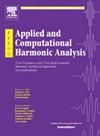实数信号处理硬件可解决逆问题
IF 3.2
2区 数学
Q1 MATHEMATICS, APPLIED
引用次数: 0
摘要
尽管深度学习(DL)取得了成功,但仍然存在严重的可靠性问题,如非稳健性。一个有趣的问题是,这些问题是由于工具不足还是深度学习的根本局限性造成的。我们从可计算性的角度出发,通过描述应用硬件带来的限制来研究这个问题。为此,我们将重点放在逆问题的类别上,其中尤其包括从测量中重建数据的任何任务。事实上,在数字硬件方面,已经推导出了解决有限维度逆问题的 DL 能力的概念障碍。本文研究了布卢姆-舒伯-斯马尔(BSS)机器的一般计算框架,描述了任意实值的处理和存储。虽然现实世界中并不存在相应的计算设备,但近年来针对实数计算硬件(通常称为 "神经形态计算")的研究和开发却在不断增加。在这项工作中,我们证明了 BSS 机器框架确实能够实现有限维逆问题的算法求解。我们的结果强调了所考虑的计算模型在准确性和可靠性问题上的影响。本文章由计算机程序翻译,如有差异,请以英文原文为准。
Inverse problems are solvable on real number signal processing hardware
Despite the success of Deep Learning (DL) serious reliability issues such as non-robustness persist. An interesting aspect is, whether these problems arise due to insufficient tools or fundamental limitations of DL. We study this question from the computability perspective by characterizing the limits the applied hardware imposes. For this, we focus on the class of inverse problems, which, in particular, encompasses any task to reconstruct data from measurements. On digital hardware, a conceptual barrier on the capabilities of DL for solving finite-dimensional inverse problems has in fact already been derived. This paper investigates the general computation framework of Blum-Shub-Smale (BSS) machines, describing the processing and storage of arbitrary real values. Although a corresponding real-world computing device does not exist, research and development towards real number computing hardware, usually referred to by “neuromorphic computing”, has increased in recent years. In this work, we show that the framework of BSS machines does enable the algorithmic solvability of finite dimensional inverse problems. Our results emphasize the influence of the considered computing model in questions of accuracy and reliability.
求助全文
通过发布文献求助,成功后即可免费获取论文全文。
去求助
来源期刊

Applied and Computational Harmonic Analysis
物理-物理:数学物理
CiteScore
5.40
自引率
4.00%
发文量
67
审稿时长
22.9 weeks
期刊介绍:
Applied and Computational Harmonic Analysis (ACHA) is an interdisciplinary journal that publishes high-quality papers in all areas of mathematical sciences related to the applied and computational aspects of harmonic analysis, with special emphasis on innovative theoretical development, methods, and algorithms, for information processing, manipulation, understanding, and so forth. The objectives of the journal are to chronicle the important publications in the rapidly growing field of data representation and analysis, to stimulate research in relevant interdisciplinary areas, and to provide a common link among mathematical, physical, and life scientists, as well as engineers.
 求助内容:
求助内容: 应助结果提醒方式:
应助结果提醒方式:


